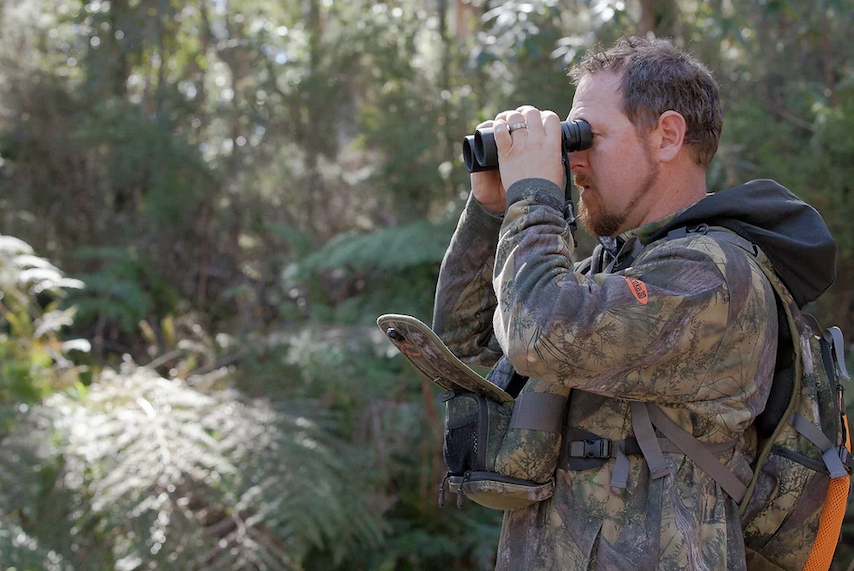About one kilometre away, you spot a majestic elk grazing in a clearing. You stop in your tracks and try to get a better angle to take a shot. You set up your rifle, take a deep breath and focus on your target. But alas, it seems to be too far away for you to make a proper shot.
This is the reality that many beginners face when they set out on their first hunting trip. This activity requires patience, skill, and most importantly, the right equipment. Sure, having proper clothes to camouflage and protect you from the elements is essential, but having quality optics can make all the difference. You can’t possibly get close enough to your target without alerting it, so you need to observe it from a distance.
What Optics Are Best for Hunting?

Depending on the terrain and the type of game you are pursuing, you may prefer certain options over others. These days, there’s an assortment of accurate and reliable hunting optics to improve your chances of success.
Binoculars
An age-old favourite, binoculars offer magnification and a wider field of view, allowing you to scout for potential targets quickly. They also come in handy when assessing the animal’s behaviour or checking if there are any obstacles between you and your target.
The main thing to look for when purchasing binoculars is the magnification power, which usually ranges from 8x to 15x. Higher magnification is beneficial for long-range hunting, but it also means a narrower field of view and a shakier image.
For instance, if you’re hunting in open areas like prairies or mountains, 10x magnification should suffice. But if you’re stalking prey through thick underbrush, a lower magnification of 8x might be better since it will provide a wider field of view.
Another important aspect to consider is the size and weight of the binoculars. You don’t want them to be too heavy or bulky, making them difficult to carry around for long periods. Look for models that are compact and not too heavy, while still providing good image quality. This helps to reduce fatigue and allows for easier maneuvering while hunting.
Range Finders
When you’ve finally spotted your target, it’s essential to know how far away it is before taking a shot. Range finders use lasers or radar technology to measure the distance between you and your target accurately. This eliminates any guesswork and ensures a more accurate shot.
Some range finders even have additional features like angle compensation, which takes into account the slope of the terrain and adjusts the distance accordingly. This is particularly useful when hunting in mountainous areas where steep inclines can affect the trajectory of your shot.
Let’s say you’re hunting for elk in the Aussie Alps, and your range finder tells you the distance in km. You can use the angle compensation feature to determine the horizontal distance, making it easier to adjust your aim.
Even if you’re not long-range shooting, a range finder can come in handy for determining the distance to your target and practising accuracy. It helps to develop a better understanding of the capabilities and limits of your weapon, allowing for more ethical and humane hunting.
Spotting Scopes
For long-range hunting or scouting, a spotting scope is an excellent tool to have in your arsenal. It offers even higher magnification than binoculars, with some models going up to 60x. This allows you to observe and evaluate potential targets from a greater distance without disturbing them.
Additionally, these hunting optics often come with interchangeable eyepieces, allowing you to customize the magnification according to your needs. Some also have built-in tripods for stability and extended viewing sessions, so you can keep an eye on your target without getting fatigued.
While spotting scopes are primarily used for hunting, they can also be handy for other activities such as birdwatching or wildlife observation. Their high magnification and image clarity make them useful for capturing close-up views of distant subjects.
In addition to being a helpful tool for locating and observing game, these tools can also assist with determining wind direction and spotting potential obstacles or hazards in the terrain. They can be especially useful for long-range shooting, where precise calculations are crucial for a successful shot.
Additional Accessories

Even if you have all of your primary hunting optics covered, there are still some additional accessories that can enhance your experience. For example, binocular harnesses can keep your binoculars secure and easily accessible, with some designs even incorporating a built-in rangefinder pouch. They normally attach to your chest or shoulder straps, so you won’t have to worry about them swinging around while you’re moving.
Another useful accessory is a tripod adapter, which allows you to mount your binoculars or spotting scope onto a tripod for increased stability. This can be especially helpful when using higher magnifications for long-range observation or shooting.
For example, if you’re using a spotting scope to scout for game at long distances, a tripod will provide much-needed stability and reduce any shaking or movement caused by hand-holding the scope. This can greatly improve your accuracy and make it easier to track your target.
